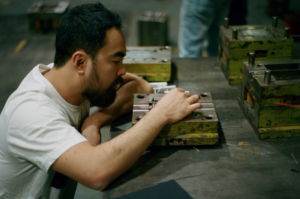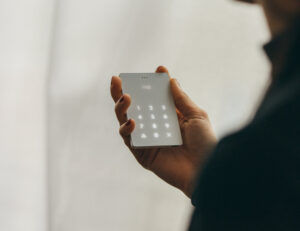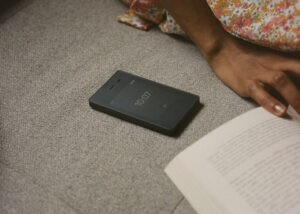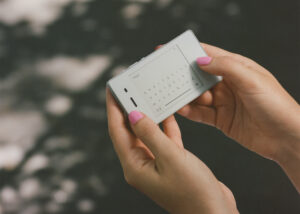The “Be Here Now” Phone: A Conversation With Light CEO Kaiwei Tang
Does time spent on your smartphone sometimes feel like it’s pulling you away from real life? And is the pull hard to resist? There’s a reason it feels that way.
Some Apps Help You, Some Apps Hook You
There are well-established and very effective design patterns for driving app users to engage in repetitive behaviors and for making people fear they’re missing out if they don’t check back often. Among the many apps that inflict these design patterns on their users, the Facebook app is a prime example, but there are thousands more. Has your own company created an app that — in the name of boosting customer engagement — might be doing this to your customers?
These design patterns have become known as dark patterns. And more and more designers are recognizing the problem and charting a different course based on advancing customers’ well-being — not just grabbing and monetizing attention. Among them are Kaiwei Tang and Joe Hollier: They cofounded a company called Light to create the Light Phone and now the Light Phone II.
Kai is the company’s CEO and will be keynoting at Forrester’s CX SF 2019 Forum, which I’ll be hosting next month. In anticipation of the event, I emailed Kai some questions about the Light Phones, what customer needs they address, and the underlying principles that guided their design.

A Conversation About The Light Phone With Kai Tang, CEO Of Light
Kai, could you start by sharing your thoughts about your concept of phone minimalism, as embodied in the Light Phone?
The catalyst was my cofounder Joe Hollier and I joining Google’s designer incubator. There, we saw a lot of products being built across mobile apps, wearables, and the internet of things that claimed to “give you back your time” and life, but we didn’t feel like that was the case. When you look at most technology today, it’s designed to fight for our time and attention.
Too often, our minds are just wandering. We are constantly distracted by our technology, but what about the things happening around us? What about our train of thought or focus? Or the person you care about the most sitting right next to you?
It’s common now to see people sit right next to each other in a restaurant and make no eye contact or conversation because they are on their smartphones. You take your kids to the park, and instead of spending quality time with them, you start checking emails on your phone. You go to a concert, and instead of enjoying the live performance, you look it at through your phone and take videos so that you can share them on social media.
We realized that being more connected doesn’t make us happier, so we set off to build a product that could encourage people to take a break from hyperconnectivity and live in the moment. And the product we built is the Light Phone.
The Light Phone respects users’ time and attention. It’s designed as a technology that empowers us rather than the other way around.

Why did you then develop the Light Phone II, adding more features — doesn’t that conflict with your commitment to simplicity?
After tens of thousands of orders for the original Light Phone and reviewing years of customer engagement, we learned that a lot of our users really enjoy going light and want to do it more often.
There is an initial anxiety when you first leave your smartphone behind, but that anxiety quickly turns into relief. FOMO (fear of missing out) is real, but you get over it, and the feeling of being in the moment is really profound. Our users wanted to use the Light Phone as their primary phone, but the absence of certain features in the original version, like texting, ride-sharing, directions, etc., though deliberate, made it tough for some users to make the full switch.
So we designed Light Phone II and the tools on it to inspire and encourage people to break away from the internet and all its noise and distraction. Intentionality of our design is critical to us. The purpose of the tool has to be utility. We made a conscious effort to ensure that what we added did not feature infinite feeds (social media, internet browser), advertisements, or other distractions like those. For instance, being able to get a taxi home via a ride-sharing app after a lovely dinner with your partner doesn’t seem like a distraction to us.
The original Light Phone was intended be used as a casual “second phone,” as a complement to your smartphone. Light Phone II is designed with the intention of being a fully functioning simple phone, whether it’s your only phone or a second phone. It gives you peace of mind, knowing you have the right tools with you but not all the noise, distraction, and manipulation.

What was your design process for creating the Light Phone?
We tested our hypothesis even before we started developing Light Phone — the idea that people would enjoy disconnecting from the internet. We gave test users a flip phone and simulated the call forwarding experience with carrier-level dialer codes. We began testing what “going light” would feel like.
Everyone described an initial anxiety, and it was more intense than we expected. You first feel like you are missing something and touch your pockets anxiously. However uncomfortable that feeling might have been, there was always a point where you forget to think about what you might be missing out on and you get completely engaged in the present world around you. It’s quite special.
We also learned that if you went “light” with friends, that initial anxiety didn’t really happen because you were too busy enjoying the time together to even think about it. If that friend stood up to go to the bathroom, you might habitually reach for your phone and then realize that you had intentionally left it at home. And that turns out to produce a feeling of relief.
Multitasking is addictive, and it is exhausting. Our attention spans are rapidly decreasing over the last few years and now seem like less than that of a goldfish. This is why a short break from connectedness can have such a profound impact on us. In fact, people didn’t use the phones that much throughout our testing. And that was by design. The value was in the absence of a smartphone, the absence of the internet — not in what the phone did or didn’t do. The more invisible, the better.
We applied these learnings to our design of the Light Phone. In thinking about the form factor, we asked, “What is it that everyone has with them all of the time?” A credit card or an ID. There will always be room for those, so it seemed like the most universally invisible form factor.
We had some credit-card-shaped plastic blocks cut out so we could experience living with that form factor. They were literally white plastic cards that did nothing, and we fell in love with them. It gave us the idea of making the phone look like a blank white card when off and to try to make the interface light up through the casing. Conceptually, it made sense, too; if this phone is designed to be used as little as possible, then the fact that there is no screen and that it is blank most of the time is perfect.
You often refer to the Light Phone as a “dumb” phone. How does a “dumb” phone serve people’s needs in today’s digitally connected world?
When we first started Light, a lot of press called us the “anti-smartphone.” But we are not anti-technology or anti-smartphone. We are just trying to be human-centric about how we create tech.
I think technology is really great in so many ways. You can video-chat with your family thousands of miles away, listen to amazing music from every corner of the world, or view photos of space and planets from your home. But when we go to sleep and wake up with our smartphones, spend more than eight hours a day on our screen instead of living in the moment, it becomes an addiction that distracts us from experiencing life. Why are we bringing our mini-computer wherever we go? What if all you want is to take a walk down the street, watch your kids play in the park, or just focus and be creative?
Technology should empower us. We designed Light Phone so people can have that option. You can choose to leave distraction behind but keep the essential tools. In my mind, this is a step forward from the extreme binary choice of “dumb phone or smartphone.” It’s similar to how we use a screwdriver or a hammer. We use these tools to get a task done quickly then get back to living our lives. We don’t swipe or stare at those tools for hours.
How does the Light Phone change peoples’ interactions with technology and the world around them?
The Light Phone is not some magic solution that will automatically cure you of your smartphone habits. The Light Phone is not always “easy.” It takes some self-awareness and discipline — a holistic approach that we hope the Light Phone will inspire.
There is an initial anxiety many users describe when first using the Light Phone. The choice to bring the Light Phone instead of your smartphone, however, can be empowering as you overcome the infinite list of excuses you might make for why you need to bring a smartphone.
Overall, our users describe their light moments as incredibly refreshing. There is an awareness that is gained in taking yourself away from the smartphone. You might find that you were more addicted than you realized and that even upon returning to the noise of your heavy phone, your perspective and relationship with the device has changed. The Light Phone helps you to appreciate your life, taking you away from the streams of advertising that will try to convince you that you are not enough and need to buy more to feel complete. Users have reported benefits to their productivity. We have a lot of artists, musicians, writers, and photographers who rely on the Light Phone as they find inspiration and create new work.
Our research certainly told us that going light is a powerful experience, and if you can find and maintain a healthier relationship to your smartphone or to the internet at large, there are likely many health benefits.
There is increasing concern about “dark patterns” — designs that manipulate people in the interest of a company in ways that conflict with their own well-being. Is the Light Phone a response to the spread of dark patterns?
I agree — what we are doing at Light is a direct response to this trend. Our time and attention are two of the most important things we have in our life, and a technology and design movement is underway to address this issue head on and provide people with a different kind of experience free of manipulation that conflicts with people’s well-being.
What’s the future for Light Phones?
We’re really excited about the launch reception for Light Phone II. We’re continuing to build a road map of optional tools users will be able to choose to add to their Light Phone II, such as directions, a calculator, timers, ride-sharing tools, hotspot tethering, and more — but not too much.
We’ve been working closely with our backers to understand what is possible and what makes sense, and it’s been a really interesting conversation. We love the idea of starting to sell other objects that complement the experience of being light, such as a camera or book — things that fit the phone’s context for how you use it.
We’re always curious of what other objects we can run through the same “light” design lens that we’ve used to create our Light Phones, and we’re looking forward to continuing to explore those possibilities. We’re trying to build a unique technology brand, founded by two artists/designers, that respects and empowers its users through beautifully designed products.
Thank you, Kai — I’m looking forward to seeing you at CX SF 2019 next month!
More On Dark Patterns
After his keynote at CX SF, Kai will sit down for an in-person chat (including audience Q&A) with my colleague Andrew Hogan, who originated and leads Forrester’s research about dark patterns. Andrew will also be keynoting on the subject of dark patterns specifically at the event.

